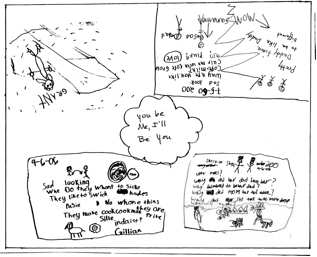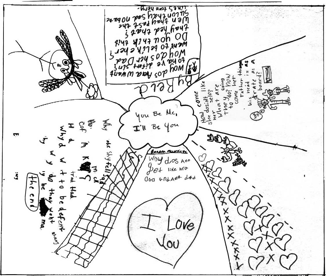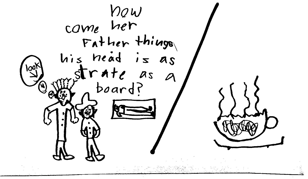Encouraging Reflection through the Graffiti Boards and Literature Circles
by Jennifer Griffith, Second Grade, Van Horne Elementary, Vignette 1 of 3
Reading aloud to children has always been a significant part of the day in my classroom. I regularly read aloud a book and spend a few minutes talking about children’s thinking in response to the book. After discussing literature circles and response strategies in our school-based teacher study group, however, I began wondering about the difference between literature circles and read aloud, particularly in relation to encouraging greater depth of thinking and talk around the books. I wondered how the opportunity to reflect before talking about a book would influence young children’s thinking. Douillard (2002) notes that many educators assume that reflection is for older students, but her teacher research with primary children indicates that, “Reflection helps students remember and actively participate in the learning experience” (p. 93). I wanted to see what would happen if I engaged my kids in reflection and so another primary teacher and I developed a plan for bringing literature circles into our classrooms.
We began our school year with the plan to devote three weeks to our readers workshop and then one week to literature circles. We continued to read aloud to our students on a daily basis and invite short discussions but during our week of literature circles we wanted to encourage more reflection and sustained talk around a book.
Our first literature circle took place in September. We chose to read You Be Me, I’ll Be You (Mandelbaum, 1990), a picture book from Belgium about a young biracial girl, Anna, who isn’t happy with the way she looks. Anna explores questions about her identity by “switching” skin colors with her white father. We chose this book because of the special relationship between a father and daughter, something we felt our kids could connect to and because of the deeper issue of feeling different and uncomfortable with your physical appearance. We were interested in seeing whether our kids would pick up on these issues and explore them in discussion. In addition to having a variety of issues that might be explored, this book was also part of the international collection at our school and so seemed like a great choice for our first discussion.
We decided to introduce the reflection by using graffiti boards (Short & Harste, 1996). This strategy is easy to use with primary students because they can respond through art and/or writing. This strategy involves placing a large sheet of paper at each table. Each group member takes a corner of the paper and writes and sketches their thoughts about the book in a graffiti fashion. Their responses, comments, sketches, quotes, and connections are not organized in any manner. The goal is to record initial responses during or right after listening to a book. Group members can then share their thinking using their graffiti as a reference. These boards can also lead to organizing and webbing their connections to find a focus for further discussion.
We spent the week reading the book everyday to our students and introducing the graffiti boards. Day one was an introduction to the book, day two was responding to the book on graffiti boards, day three was sharing our boards with the class, and the final day was a literature circle using our graffiti boards as a springboard for our discussion.
The first day the kids and I talked about our focus on learning how to talk about books. We discussed the importance of thinking about our reading and having the opportunity to reflect on our thoughts and connections and then talk about them with others. I chose not to give a lot of direction to what this process of reading, reflecting, and discussing would look like; I wanted the kids to develop their own approaches to the process that fit their personalities. So often, we give kids step-by-step directions for how to do something; I wanted this experience to be a self-exploration of how to reflect on a story and have a deep conversation about literature. The endeavor was new to me as well so I would be exploring what worked for them.
I introduced You Be Me, I’ll Be You by showing the cover and explaining that we would read the book everyday that week. Each time I wanted them to look and listen for something new from the story and to hang on to those thoughts. We read the book as a whole group that day and I showed the illustrations. I taught them the response strategy of Say Something (Short & Harste, 1996), pausing at several different points in reading the story aloud and asking them to turn to a neighbor and share their thinking about the story in the form of a connection, question or prediction. The kids did turn and talk as pairs but had a hard time knowing what to say to each other, almost as if they were afraid of not having the ‘right’ answer. My goal was to encourage them to begin reflecting on their thinking by providing time to pause and think during the story. I knew it would take some time for them to feel comfortable with this kind of reflection and talk.
The second day of reading You Be Me, I’ll Be You, I introduced graffiti boards. I demonstrated the process of responding through a graffiti board by having a colleague, Anna, read King of the Playground (Naylor, 1994), while I stood at the front of the room with my own graffiti board. I represented my thinking aloud by sketching pictures of my connections to the story and characters, writing connections to my own life, noting my wonderings or questions about the story, and jotting quotes that resonated with me. This process allowed the kids to see what a graffiti board looked like and to view my reflection process.
The kids returned to their tables with a large piece of paper and markers. I explained that I would read the story but not show the illustrations this time and that while I was reading they could reflect on their boards using whatever response technique they wanted. I encouraged them to try out the different ways of responding that they had seen me use on my board but let them make their own decisions about what they wanted to do. I walked around the room reading the book and observing their first experience with this type of response. I was really excited with what I was seeing – the kids were asking thoughtful questions and expressing their thinking both visually and in writing. I especially enjoyed seeing the active engagement of all of the students.
After studying the graffiti boards of each group, I noticed many common threads and found that their responses could be grouped into three categories. A large majority of the kids asked the question, in some form or another, of “Why does Anna not like herself or her skin?” The kids had a hard time grasping the idea of not liking something about oneself. Their focus wasn’t on Anna’s concern that she was a different race than her father but on why she wasn’t happy with herself. They truly seemed puzzled as to why she didn’t like herself and why she would want to be like her father. It was refreshing to see these kids question why a young girl would have a problem with her appearance.
Reid was the only one who brought up the issue of people not liking their appearance. She referenced the part in the book where Anna and her father walk by the salon and they see that no one likes their hair; that everyone is altering it in some fashion. Many kids did not seem to see skin color as an issue; no one brought up the fact that she had a different skin color than her dad even though several of my students come from biracial families. Only one boy, who is white, commented on skin color, saying, “The girl wants to be her dad, the girl wants some white skin.”
Another category of their reflections was questions and wonderings about the language used in the story. Children wondered “How come her father thinks his head is as straight as a board?”, “What is coffee-milk?”, “What is pluff?” Many kids attempted to illustrate what these might look like in a creative manner. “Head straight as a board” was a favorite to draw. When the kids later shared their graffiti boards with the class, many of them discussed possible definitions such as “pluff” being a cloud or “coffee-milk” as a color name. Their definitions were as creative as their illustrations of these new words.
A third category on their graffiti boards was wondering, “Why was the mom mad at them? Why did she think they were clowns?’” None of the children could figure out why the mom was upset with Anna and her father when they met her after both had ‘switched’ skin colors. One student did suggest that the mom was embarrassed by them but didn’t develop his thinking. Several wondered why the young girl who passes by Anna and her father on their way to meet the mother points at them and asks if there is a circus in town, but nobody brought up this pivotal moment for discussion.
The issues that I had identified as my reason for choosing this book weren’t explored fully by the children, perhaps because those issues did not connect to their life experiences at this age. I noticed after looking at these categories and the children’s responses that there were no personal connections on the boards, which surprised me because young children usually make many personal connections. In our second literature discussion and graffiti boards on Grandpa & Bo by Kevin Henkes (2002), there were many personal connections, so the lack of personal connections with You Be Me, I’ll Be You seemed to be due to their lack of experience with the content of the story. It could also have been that talking about skin color and race was new for them and so they avoided the topic.
On the third day of our work with You Be Me, I’ll Be You, the kids shared their graffiti boards with the whole class; each student focusing on their section and sharing their reflections. This part of the process took the longest and by the last graffiti board the kids had grown impatient. Many noticed that their responses were similar and we discussed how these would be great ideas to bring up in our literature circle the following day.
The fourth and last day with this book was our discussion day. We went to the library, which was more conducive for 28 second graders to have a literature circle. We sat in a large circle and I placed the graffiti boards in the center to use as a springboard for ideas/topics to spark conversation. I explained to the students that there was no need to raise their hands – they would know it was their turn to speak when no one else was talking. This was the only guideline I provided.
The discussion began but unfortunately didn’t go as I had envisioned. Kids talked over each other and too many side conversations took place. They did use the graffiti boards as a springboard, but not in the way I had hoped; many read off of their boards rather than using their questions to spark a discussion.
I believe the reason for the lack of depth in their conversation was because this was our first discussion and so this type of talk was not yet familiar or comfortable for the kids. If I had chosen to prompt the conversation it may have been more successful but my goal was to sit back and see what did and did not work so I would know how to change the process for the next time.
Four weeks later my kids and I were ready for another literature circle by reflecting before discussing. This time we chose the book Grandpa & Bo (Henkes, 2002) because it connected with the theme of family relationships that we had been exploring. I used the same schedule as with the previous book so by the third day the kids were ready to share their graffiti boards. This time around the story supported more personal connections and less questions and wonderings. The sketches were more related to the setting of the story as opposed to the characters, which made for beautiful boards. Instead of sharing our graffiti boards as a whole class we shared at the tables, which shortened the experience.
We decided to create a web to narrow our thinking and help us focus our discussion. Our web was a combination of our reflections from our boards. I decided to do this literature circle in our classroom because the kids felt more at home there. This setting seemed to support them in a more informal approach to their discussion. The kids began by sharing lots of personal connections, ones that they had represented on their boards. By the end of this literature circle, I felt they were close to having those meaningful conversations that I had envisioned for our classroom.
Although the students struggled in our first literature circle, I reminded myself that both the discussion process and the reflection on graffiti boards were new for all of us. This first experience was a stepping-stone in what would be a year filled with learning how to talk meaningfully about literature and utilizing reflection to elicit this type of talk. When I examine the talk during read alouds where students are asked to immediately make a few comments and literature circles where they have time to first reflect, I can see how providing them with time to reflect on their questions, wonderings and connections allows for more insightful conversations. I agree with Douillard (2002) that, “Reflective activities in the classroom help make thinking more visible, enabling students to learn from one another and to gain greater insights into their own thinking and learning processes” (p. 93).
Dewey (1938) argues that reflection provides learners with the opportunity to organize ideas so that they are more available for pushing the learner’s own thinking and for sharing that thinking with others. Reflection supports learners in connecting with what they already know, considering alternative perspectives, posing and solving problems, and organizing their experiences. Encouraging young children to regularly engage in reflection helps them develop purpose and control over their own thinking and learning. I believe that literature circles provide one way to encourage young children to take on reflection as a means of thoughtfully considering and questioning their lives and learning.
References
Dewey, J. (1938). Experience and education. New York: Collier.
Douillard, K. (2002). Going past done: Creating time for reflection in the classroom. Language Arts, 80, 92-99.
Henkes, K. (2002). Grandpa & Bo. New York: Greenwillow.
Mandelbaum, P. (1990). You be me, I’ll be you. La Jolla, CA; Kane/Miller.
Naylor, P. (1994). King of the playground. New York: Aladdin.
Short, K. & Harste, J. (1996). Creating classrooms for authors and inquirers. Portsmouth, NH: Heinemann.
WOW Stories, Volume I, Issue 1 by Worlds of Words is licensed under a Creative Commons Attribution-NonCommercial-ShareAlike 4.0 International License.
Based on a work at https://wowlit.org/on-line-publications/stories/storiesi1/.



